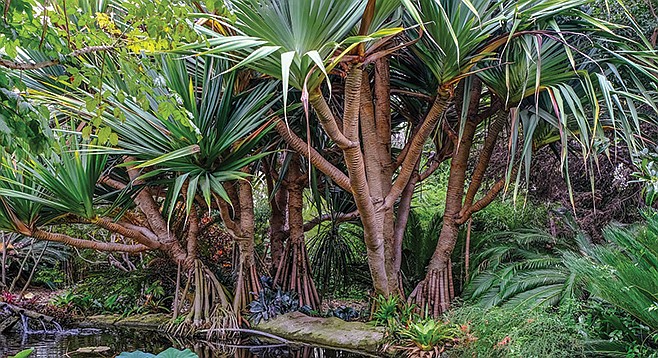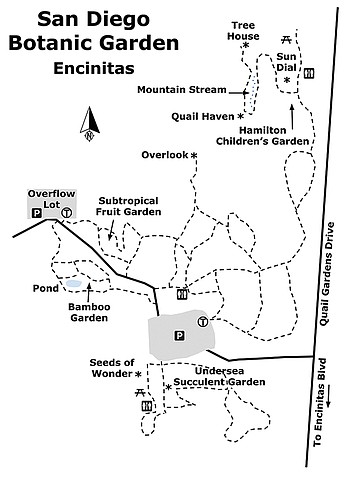 Facebook
Facebook
 X
X
 Instagram
Instagram
 TikTok
TikTok
 Youtube
Youtube

San Diego Botanic Garden has a collection of over 4,000 unique plants, many found at exotic locations throughout the world. You can explore habitats from places you would like to visit without ever leaving San Diego. This is also a place to learn about California native plants, especially those of coastal maritime chaparral: a small fragment of this endangered habitat is preserved within the Garden. The Garden also holds numerous special events and classes.

The Garden is open every day from 9 am to 5 pm, except December 25. It is a great place for walkers, birders, photographers, naturalists wanting to expand their knowledge of plants, and families with children. In fact, there are special gardens for children as well as educational exhibits on Native Americans: how they lived, and how they used native plants in their lives.
If you arrive on a busy day, you may have to park in the overflow lot on the western side of the Garden, but this is actually a good place to begin exploring. Start by wandering through the Bamboo Garden, the largest public collection of bamboo varieties in the country. You may be surprised to learn that bamboo is a woody grass, often a very large grass. Another oddity is that some types of bamboo remain vegetative for up to a hundred years or more. Then they flower, produce seeds, and die.
The path through the bamboo garden eventually leads you to a pond containing its own exotic plants, including an Amazon water lily named for the English Queen Victoria (Victoria rigea). In the tropics, its floating leaves can reach 6 feet in diameter, each with a 3- to 4-inch high rim. In cooler San Diego, it rarely comes close to half that size. Another rarity in sub-tropical North America is the pandan or screw pine (Pandanas amaryllifolius), also sometimes called screw palm; however, it is a monocot and closer to a lily than either a pine or a palm. Another name for this species of Pandanas is the fragrant pandan. Its leaves have a delightful fragrance which is used to flavor other foods in tropical southeast Asia. Pandan leaves are too fibrous to eat, but they impart a delightful flavor to many regional dishes, especially rice dishes.
The Subtropical Fruit Garden is just across the main path from the Bamboo Garden. Here you will find many plants familiar to you, such as avocado, papaya, and guava, but you will also find many you have never seen before, though all of these could be grown here in San Diego. Two that you may be interested in eating some day are the dragon fruit (Hylocereus undatus) and the wax jumbu (Syzygium samarangense). Hylocereus, though a native of Mexico, now is more often grown commercially in tropical Asia. It is a vining cactus, similar to the Christmas cactus commonly grown here as a houseplant. But it differs from our Christmas cactus by having huge flowers that produce delicious fruits that are said to taste like a cross between pineapple and strawberry. The wax jambu is the fruit of a fast growing tree, a native of Malaysia, and now grown throughout Asian tropics, where its fruit are readily available in markets. In the Seeds of Wonder Garden, pre-school age children will find a dinosaur’s garden, a model railroad, and a playhouse. In this same area, check out the Undersea Succulent Garden. These are not aquatic plants, but plants whose colors suggest a bed of coral. One is a large pony tail palm (Beaucarnea recurvata) with grossly swollen base (it stores water) and brilliant red flowers when in bloom.
In the Hamilton Children’s Garden, older children can climb on a tree house, see live quail, play in a stream, watch a huge sundial, and make music. If you brought lunch for your family, there are picnic tables in both the Hamilton and the Seeds of Wonder Gardens.
This is a very brief introduction to the many things you can see and do here. It is a place to make your own adventure, have a bit of fun, and learn about the amazing world of plants.
Driving directions: (Encinitas) From I-5, exit at Encinitas Boulevard and go right (east) for 0.4 mile to Quail Gardens Drive. Turn left on Quail Gardens Drive and continue an additional 0.3 mile to the Garden entrance, on your left. Hiking length: Four miles of trails wind through the 37 acres of park. The main trail is a paved road roughly a half-mile in length, but there are numerous dirt trails branching off of it. Easy with 100 feet elevation gain/loss. Most trails are an easy stroll, often shaded by tall trees that can accommodate strollers and wheelchairs, though some have a few stairs to negotiate. Dogs and other pets are not allowed in the Garden, although an exception is made for service animals. NOTE: There is an entrance fee; check the Garden’s website for information.


San Diego Botanic Garden has a collection of over 4,000 unique plants, many found at exotic locations throughout the world. You can explore habitats from places you would like to visit without ever leaving San Diego. This is also a place to learn about California native plants, especially those of coastal maritime chaparral: a small fragment of this endangered habitat is preserved within the Garden. The Garden also holds numerous special events and classes.

The Garden is open every day from 9 am to 5 pm, except December 25. It is a great place for walkers, birders, photographers, naturalists wanting to expand their knowledge of plants, and families with children. In fact, there are special gardens for children as well as educational exhibits on Native Americans: how they lived, and how they used native plants in their lives.
If you arrive on a busy day, you may have to park in the overflow lot on the western side of the Garden, but this is actually a good place to begin exploring. Start by wandering through the Bamboo Garden, the largest public collection of bamboo varieties in the country. You may be surprised to learn that bamboo is a woody grass, often a very large grass. Another oddity is that some types of bamboo remain vegetative for up to a hundred years or more. Then they flower, produce seeds, and die.
The path through the bamboo garden eventually leads you to a pond containing its own exotic plants, including an Amazon water lily named for the English Queen Victoria (Victoria rigea). In the tropics, its floating leaves can reach 6 feet in diameter, each with a 3- to 4-inch high rim. In cooler San Diego, it rarely comes close to half that size. Another rarity in sub-tropical North America is the pandan or screw pine (Pandanas amaryllifolius), also sometimes called screw palm; however, it is a monocot and closer to a lily than either a pine or a palm. Another name for this species of Pandanas is the fragrant pandan. Its leaves have a delightful fragrance which is used to flavor other foods in tropical southeast Asia. Pandan leaves are too fibrous to eat, but they impart a delightful flavor to many regional dishes, especially rice dishes.
The Subtropical Fruit Garden is just across the main path from the Bamboo Garden. Here you will find many plants familiar to you, such as avocado, papaya, and guava, but you will also find many you have never seen before, though all of these could be grown here in San Diego. Two that you may be interested in eating some day are the dragon fruit (Hylocereus undatus) and the wax jumbu (Syzygium samarangense). Hylocereus, though a native of Mexico, now is more often grown commercially in tropical Asia. It is a vining cactus, similar to the Christmas cactus commonly grown here as a houseplant. But it differs from our Christmas cactus by having huge flowers that produce delicious fruits that are said to taste like a cross between pineapple and strawberry. The wax jambu is the fruit of a fast growing tree, a native of Malaysia, and now grown throughout Asian tropics, where its fruit are readily available in markets. In the Seeds of Wonder Garden, pre-school age children will find a dinosaur’s garden, a model railroad, and a playhouse. In this same area, check out the Undersea Succulent Garden. These are not aquatic plants, but plants whose colors suggest a bed of coral. One is a large pony tail palm (Beaucarnea recurvata) with grossly swollen base (it stores water) and brilliant red flowers when in bloom.
In the Hamilton Children’s Garden, older children can climb on a tree house, see live quail, play in a stream, watch a huge sundial, and make music. If you brought lunch for your family, there are picnic tables in both the Hamilton and the Seeds of Wonder Gardens.
This is a very brief introduction to the many things you can see and do here. It is a place to make your own adventure, have a bit of fun, and learn about the amazing world of plants.
Driving directions: (Encinitas) From I-5, exit at Encinitas Boulevard and go right (east) for 0.4 mile to Quail Gardens Drive. Turn left on Quail Gardens Drive and continue an additional 0.3 mile to the Garden entrance, on your left. Hiking length: Four miles of trails wind through the 37 acres of park. The main trail is a paved road roughly a half-mile in length, but there are numerous dirt trails branching off of it. Easy with 100 feet elevation gain/loss. Most trails are an easy stroll, often shaded by tall trees that can accommodate strollers and wheelchairs, though some have a few stairs to negotiate. Dogs and other pets are not allowed in the Garden, although an exception is made for service animals. NOTE: There is an entrance fee; check the Garden’s website for information.
Comments